Pumping Station Desing - Second Edition by Robert L. Sanks, George Tchobahoglous, Garr M. Jones
Подождите немного. Документ загружается.

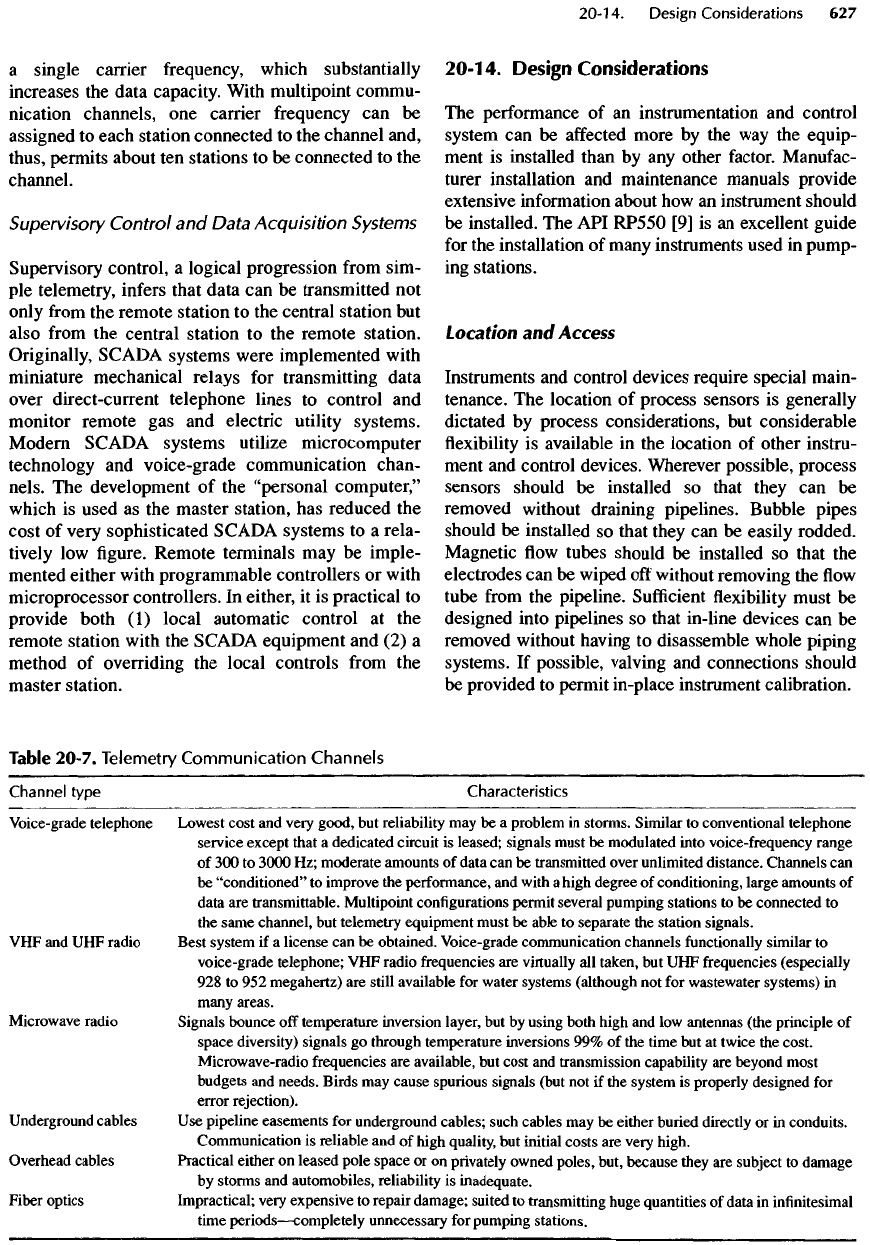
a
single carrier
frequency,
which substantially
increases
the
data capacity. With multipoint commu-
nication
channels,
one
carrier frequency
can be
assigned
to
each station connected
to the
channel and,
thus,
permits about
ten
stations
to be
connected
to the
channel.
Supervisory
Control
and
Data Acquisition Systems
Supervisory
control,
a
logical
progression
from
sim-
ple
telemetry, infers that data
can be
transmitted
not
only
from
the
remote station
to the
central station
but
also
from
the
central station
to the
remote station.
Originally,
SCADA systems were implemented with
miniature
mechanical relays
for
transmitting data
over
direct-current telephone lines
to
control
and
monitor
remote
gas and
electric utility systems.
Modern
SCADA systems utilize microcomputer
technology
and
voice-grade communication chan-
nels.
The
development
of the
"personal computer,"
which
is
used
as the
master station,
has
reduced
the
cost
of
very sophisticated SCADA systems
to a
rela-
tively
low figure.
Remote terminals
may be
imple-
mented
either with programmable controllers
or
with
microprocessor controllers.
In
either,
it is
practical
to
provide
both
(1)
local automatic control
at the
remote station with
the
SCADA equipment
and (2) a
method
of
overriding
the
local controls
from
the
master
station.
20-14.
Design Considerations
The
performance
of an
instrumentation
and
control
system
can be
affected
more
by the way the
equip-
ment
is
installed than
by any
other
factor.
Manufac-
turer
installation
and
maintenance manuals provide
extensive
information about
how an
instrument should
be
installed.
The API
RP550
[9] is an
excellent guide
for
the
installation
of
many instruments used
in
pump-
ing
stations.
Location
and
Access
Instruments
and
control devices require special main-
tenance.
The
location
of
process sensors
is
generally
dictated
by
process considerations,
but
considerable
flexibility is
available
in the
location
of
other instru-
ment
and
control devices. Wherever possible, process
sensors should
be
installed
so
that they
can be
removed
without draining pipelines. Bubble pipes
should
be
installed
so
that they
can be
easily rodded.
Magnetic
flow
tubes should
be
installed
so
that
the
electrodes
can be
wiped
off
without removing
the flow
tube
from
the
pipeline.
Sufficient
flexibility
must
be
designed
into pipelines
so
that in-line devices
can be
removed without having
to
disassemble whole piping
systems.
If
possible,
valving
and
connections should
be
provided
to
permit
in-place
instrument calibration.
Table
20-7.
Telemetry
Communication
Channels
Channel type Characteristics
Voice-grade telephone Lowest cost
and
very
good,
but
reliability
may be a
problem
in
storms. Similar
to
conventional
telephone
service
except that
a
dedicated
circuit
is
leased;
signals must
be
modulated into voice-frequency range
of
300 to
3000
Hz;
moderate
amounts
of
data
can be
transmitted over unlimited distance. Channels
can
be
"conditioned"
to
improve
the
performance,
and
with
a
high
degree
of
conditioning, large amounts
of
data
are
transmittable.
Multipoint configurations permit several pumping stations
to be
connected
to
the
same channel,
but
telemetry equipment must
be
able
to
separate
the
station
signals.
VHF
and UHF
radio Best system
if a
license
can be
obtained.
Voice-grade communication channels functionally similar
to
voice-grade
telephone;
VHF
radio frequencies
are
virtually
all
taken,
but UHF
frequencies
(especially
928 to 952
megahertz)
are
still available
for
water systems (although
not for
wastewater systems)
in
many areas.
Microwave
radio
Signals bounce
off
temperature inversion layer,
but by
using both high
and low
antennas
(the
principle
of
space
diversity) signals
go
through temperature inversions
99% of the
time
but at
twice
the
cost.
Microwave-radio frequencies
are
available,
but
cost
and
transmission capability
are
beyond most
budgets
and
needs.
Birds
may
cause spurious signals (but
not if the
system
is
properly designed
for
error rejection).
Underground cables
Use
pipeline
easements
for
underground cables; such cables
may be
either buried directly
or in
conduits.
Communication
is
reliable
and of
high quality,
but
initial
costs
are
very high.
Overhead cables
Practical
either
on
leased
pole
space
or on
privately owned
poles,
but,
because
they
are
subject
to
damage
by
storms
and
automobiles, reliability
is
inadequate.
Fiber
optics Impractical; very expensive
to
repair damage; suited
to
transmitting huge quantities
of
data
in
infinitesimal
time
periods—completely
unnecessary
for
pumping stations.
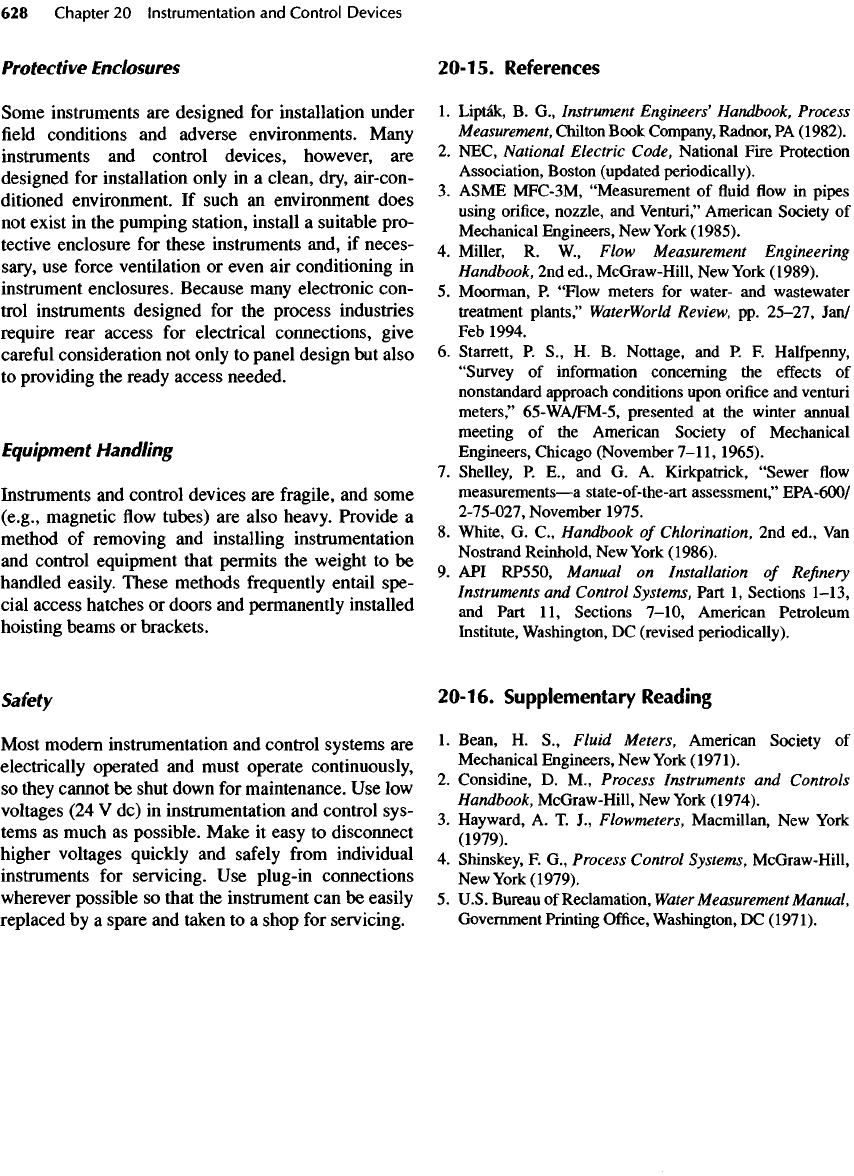
Protective Enclosures
Some instruments
are
designed
for
installation under
field
conditions
and
adverse environments. Many
instruments
and
control devices, however,
are
designed
for
installation only
in a
clean, dry, air-con-
ditioned environment.
If
such
an
environment does
not
exist
in the
pumping station, install
a
suitable pro-
tective enclosure
for
these instruments and,
if
neces-
sary,
use
force ventilation
or
even
air
conditioning
in
instrument
enclosures. Because
many
electronic con-
trol instruments designed
for the
process industries
require
rear access
for
electrical connections, give
careful
consideration
not
only
to
panel design
but
also
to
providing
the
ready access needed.
Equipment Handling
Instruments
and
control devices
are
fragile,
and
some
(e.g., magnetic
flow
tubes)
are
also heavy. Provide
a
method
of
removing
and
installing instrumentation
and
control equipment that permits
the
weight
to be
handled
easily. These methods frequently entail spe-
cial access hatches
or
doors
and
permanently installed
hoisting beams
or
brackets.
Safety
Most
modern instrumentation
and
control systems
are
electrically operated
and
must operate continuously,
so
they cannot
be
shut
down
for
maintenance.
Use low
voltages
(24 V dc) in
instrumentation
and
control sys-
tems
as
much
as
possible.
Make
it
easy
to
disconnect
higher voltages quickly
and
safely
from
individual
instruments
for
servicing.
Use
plug-in connections
wherever
possible
so
that
the
instrument
can be
easily
replaced
by a
spare
and
taken
to a
shop
for
servicing.
20-15.
References
1.
Liptak,
B.
G.,
Instrument Engineers'
Handbook,
Process
Measurement,
Chilton
Book
Company, Radnor,
PA
(1982).
2.
NEC, National Electric Code,
National
Fire
Protection
Association,
Boston
(updated
periodically).
3.
ASME
MFC-3M,
"Measurement
of fluid flow in
pipes
using
orifice,
nozzle,
and
Venturi,"
American
Society
of
Mechanical
Engineers,
New
York
(1985).
4.
Miller,
R.
W.,
Flow Measurement Engineering
Handbook,
2nd
ed.,
McGraw-Hill,
New
York
(1989).
5.
Moorman,
P.
"How
meters
for
water-
and
wastewater
treatment
plants,"
WaterWorld
Review,
pp.
25-27,
Jan/
Feb
1994.
6.
Starrett,
P.
S.,
H. B.
Nottage,
and P F.
Halfpenny,
"Survey
of
information
concerning
the
effects
of
nonstandard
approach
conditions
upon orifice
and
venturi
meters,"
65-WA/FM-5,
presented
at the
winter
annual
meeting
of the
American
Society
of
Mechanical
Engineers,
Chicago
(November
7-1
1,
1965).
7.
Shelley,
P.
E.,
and G. A.
Kirkpatrick,
"Sewer
flow
measurements
—
a
state-of-the-art
assessment,"
EPA-600/
2-75-027,
November
1975.
8.
White,
G.
C.,
Handbook
of
Chlorination,
2nd
ed.,
Van
Nostrand
Reinhold,
New
York
(1986).
9. API
RP550,
Manual
on
Installation
of
Refinery
Instruments
and
Control Systems,
Part
1,
Sections
1-13,
and
Part
11,
Sections
7-10,
American
Petroleum
Institute,
Washington,
DC
(revised
periodically).
20-16.
Supplementary Reading
1.
Bean,
H.
S.,
Fluid Meters,
American
Society
of
Mechanical
Engineers,
New
York
(1971).
2.
Considine,
D.
M.,
Process Instruments
and
Controls
Handbook,
McGraw-Hill,
New
York
(1974).
3.
Hay
ward,
A. T.
J.,
Flowmeters,
Macmillan,
New
York
(1979).
4.
Shinskey,
F.
G.,
Process Control Systems,
McGraw-Hill,
New
York
(1979).
5.
U.S. Bureau
of
Reclamation,
Water
Measurement Manual,
Government
Printing
Office, Washington,
DC
(1971).
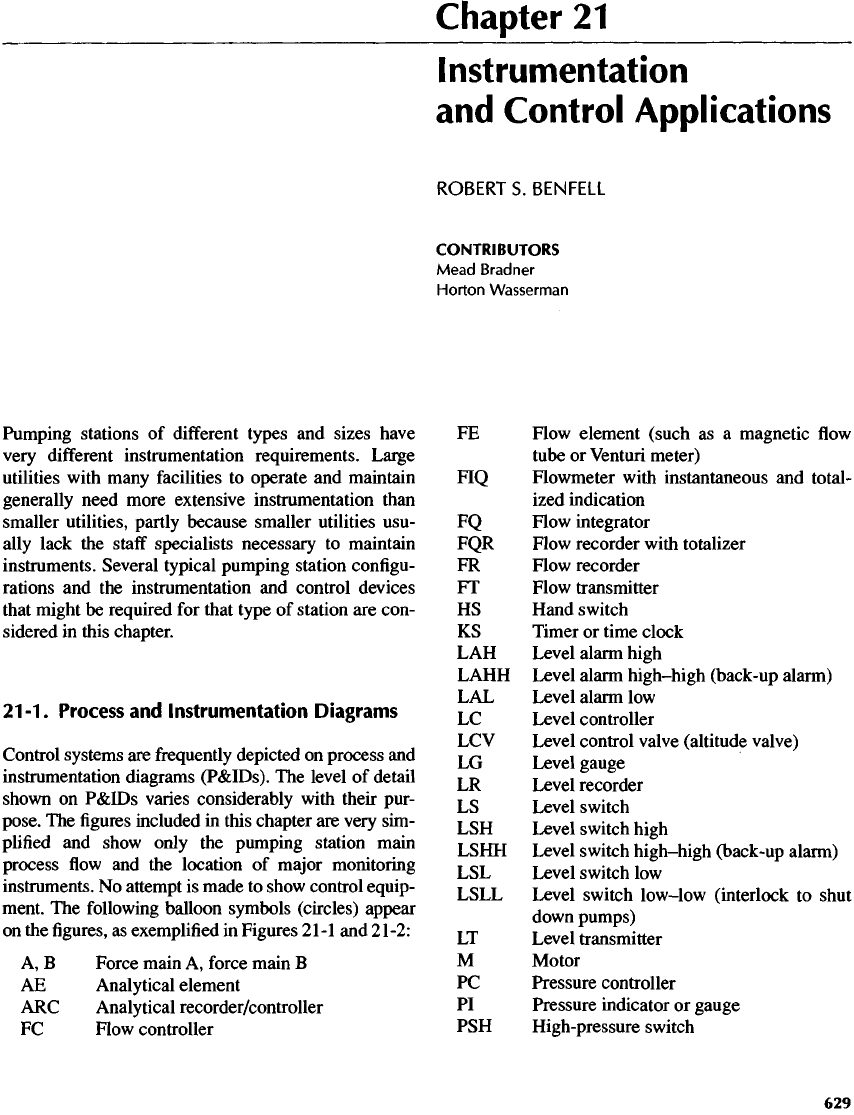
Pumping
stations
of
different
types
and
sizes have
very
different
instrumentation requirements. Large
utilities with
many
facilities
to
operate
and
maintain
generally need more extensive instrumentation than
smaller utilities, partly because smaller utilities usu-
ally
lack
the
staff
specialists necessary
to
maintain
instruments.
Several typical pumping station
configu-
rations
and the
instrumentation
and
control devices
that
might
be
required
for
that type
of
station
are
con-
sidered
in
this chapter.
21-1. Process
and
Instrumentation Diagrams
Control
systems
are
frequently
depicted
on
process
and
instrumentation
diagrams
(P&IDs).
The
level
of
detail
shown
on
P&IDs varies considerably with their pur-
pose.
The figures
included
in
this chapter
are
very sim-
plified
and
show only
the
pumping station main
process
flow and the
location
of
major
monitoring
instruments.
No
attempt
is
made
to
show control equip-
ment.
The
following balloon symbols (circles) appear
on
the figures, as
exemplified
in
Figures
21-1
and
21-2:
A,
B
Force
main
A,
force main
B
AE
Analytical
element
ARC
Analytical recorder/controller
FC
Flow controller
Chapter
21
Instrumentation
and
Control
Applications
ROBERTS.
BENFELL
CONTRIBUTORS
Mead
Bradner
Morton
Wasserman
FE Row
element (such
as a
magnetic
flow
tube
or
Venturi
meter)
FIQ
Flowmeter
with instantaneous
and
total-
ized indication
FQ
Flow integrator
FQR
Flow recorder with totalizer
FR
Flow recorder
FT
Flow transmitter
HS
Hand switch
KS
Timer
or
time clock
LAH
Level alarm high
LAHH Level alarm
high-high
(back-up alarm)
LAL
Level alarm
low
LC
Level controller
LCV
Level control valve (altitude valve)
LG
Level gauge
LR
Level
recorder
LS
Level switch
LSH
Level switch high
LSHH Level switch
high-high
(back-up alarm)
LSL
Level switch
low
LSLL Level switch
low-low
(interlock
to
shut
down
pumps)
LT
Level transmitter
M
Motor
PC
Pressure controller
PI
Pressure indicator
or
gauge
PSH
High-pressure switch
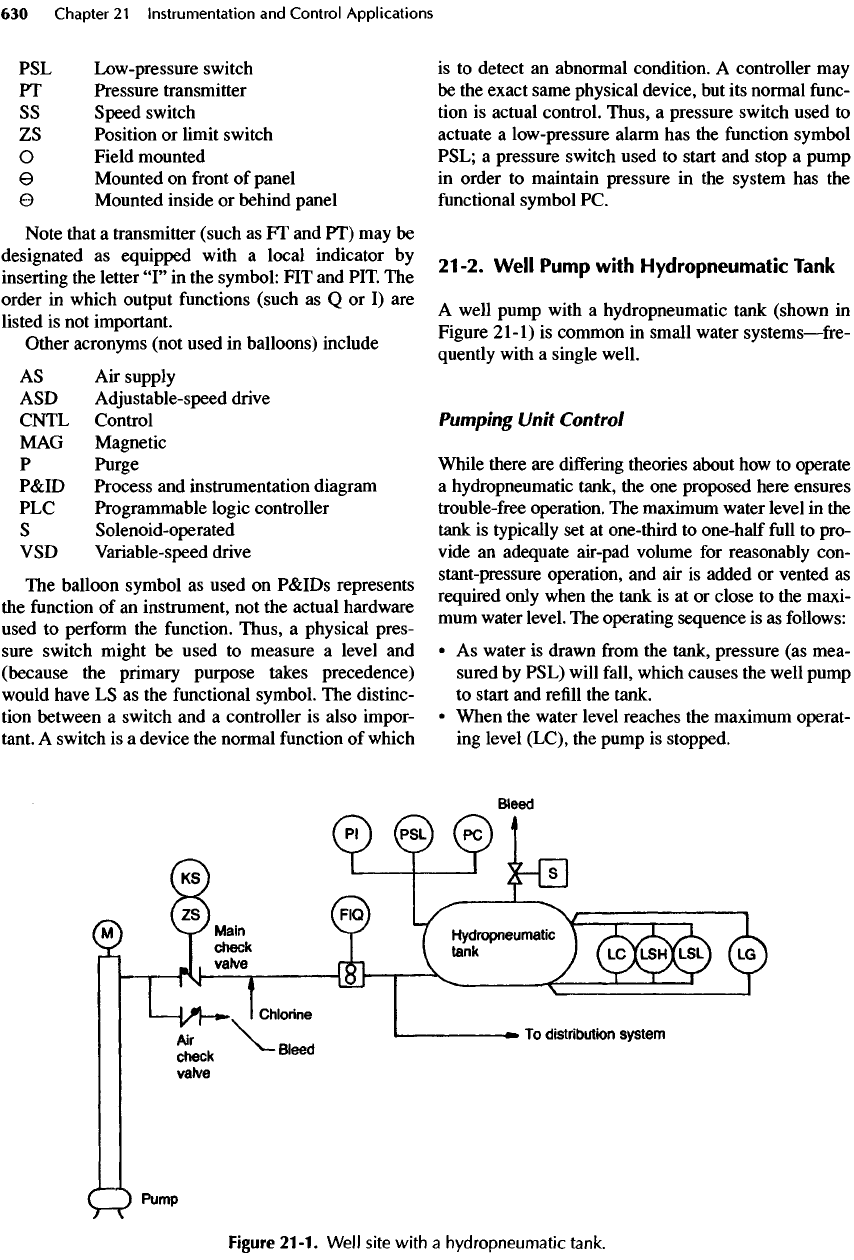
PSL
Low-pressure switch
PT
Pressure transmitter
SS
Speed switch
ZS
Position
or
limit switch
O
Field mounted
©
Mounted
on
front
of
panel
©
Mounted inside
or
behind panel
Note that
a
transmitter (such
as FT and PT) may be
designated
as
equipped
with
a
local
indicator
by
inserting
the
letter
"I" in the
symbol:
FIT and
PIT.
The
order
in
which output
functions
(such
as Q or I) are
listed
is not
important.
Other acronyms (not used
in
balloons) include
AS
Air
supply
ASD
Adjustable-speed drive
CNTL Control
MAG
Magnetic
P
Purge
P&ID
Process
and
instrumentation diagram
PLC
Programmable logic controller
S
Solenoid-operated
VSD
Variable-speed drive
The
balloon symbol
as
used
on
P&IDs
represents
the
function
of an
instrument,
not the
actual hardware
used
to
perform
the
function. Thus,
a
physical pres-
sure
switch might
be
used
to
measure
a
level
and
(because
the
primary purpose takes precedence)
would
have
LS as the
functional symbol.
The
distinc-
tion between
a
switch
and a
controller
is
also impor-
tant.
A
switch
is a
device
the
normal
function
of
which
is
to
detect
an
abnormal condition.
A
controller
may
be the
exact same physical device,
but its
normal
func-
tion
is
actual control. Thus,
a
pressure switch used
to
actuate
a
low-pressure alarm
has the
function
symbol
PSL;
a
pressure switch used
to
start
and
stop
a
pump
in
order
to
maintain pressure
in the
system
has the
functional
symbol
PC.
21-2.
Well
Pump
with Hydropneumatic
Tank
A
well pump with
a
hydropneumatic
tank (shown
in
Figure
21-1)
is
common
in
small water
systems
—
fre-
quently with
a
single well.
Pumping Unit Control
While there
are
differing
theories about
how to
operate
a
hydropneumatic tank,
the one
proposed here ensures
trouble-free
operation.
The
maximum water level
in the
tank
is
typically
set at
one-third
to
one-half
full
to
pro-
vide
an
adequate air-pad volume
for
reasonably
con-
stant-pressure operation,
and air is
added
or
vented
as
required only when
the
tank
is at or
close
to the
maxi-
mum
water level.
The
operating sequence
is as
follows:
• As
water
is
drawn
from
the
tank, pressure
(as
mea-
sured
by
PSL) will
fall,
which causes
the
well pump
to
start
and
refill
the
tank.
•
When
the
water level reaches
the
maximum operat-
ing
level (LC),
the
pump
is
stopped.
Figure
21-1.
Well
site
with
a
hydropneumatic tank.
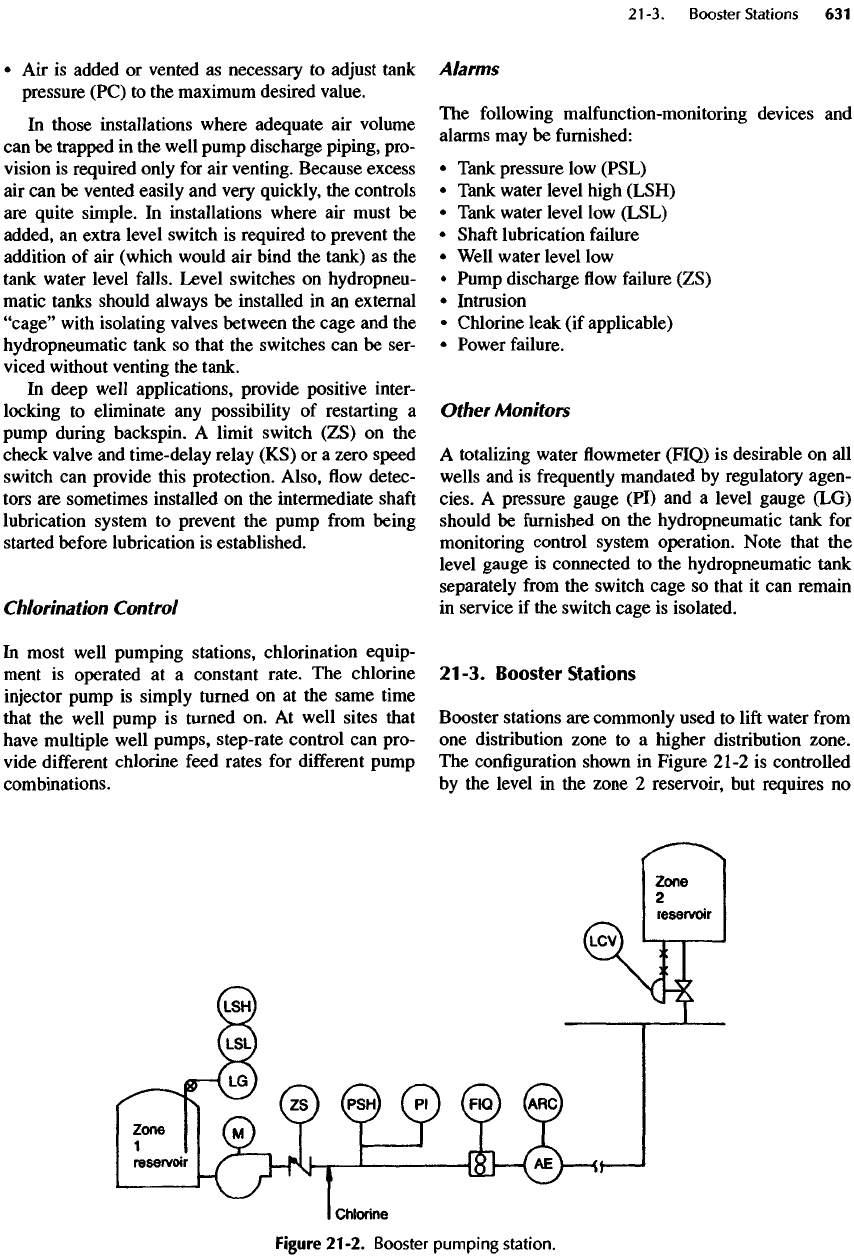
• Air is
added
or
vented
as
necessary
to
adjust
tank
pressure (PC)
to the
maximum desired value.
In
those installations where adequate
air
volume
can
be
trapped
in the
well pump discharge piping, pro-
vision
is
required only
for air
venting. Because excess
air
can be
vented easily
and
very quickly,
the
controls
are
quite simple.
In
installations where
air
must
be
added,
an
extra level switch
is
required
to
prevent
the
addition
of air
(which would
air
bind
the
tank)
as the
tank
water level
falls.
Level switches
on
hydropneu-
matic
tanks should always
be
installed
in an
external
"cage"
with isolating valves between
the
cage
and the
hydropneumatic
tank
so
that
the
switches
can be
ser-
viced without venting
the
tank.
In
deep
well applications, provide
positive
inter-
locking
to
eliminate
any
possibility
of
restarting
a
pump
during
backspin.
A
limit switch
(ZS)
on the
check valve
and
time-delay relay (KS)
or a
zero
speed
switch
can
provide this protection. Also,
flow
detec-
tors
are
sometimes installed
on the
intermediate
shaft
lubrication system
to
prevent
the
pump
from
being
started before lubrication
is
established.
Chlorination
Control
In
most well pumping stations,
chlorination
equip-
ment
is
operated
at a
constant rate.
The
chlorine
injector
pump
is
simply turned
on at the
same time
that
the
well pump
is
turned
on. At
well sites that
have multiple well pumps, step-rate control
can
pro-
vide
different
chlorine
feed
rates
for
different
pump
combinations.
Alarms
The
following malfunction-monitoring devices
and
alarms
may be
furnished:
•
Tank pressure
low
(PSL)
•
Tank water level high (LSH)
•
Tank water level
low
(LSL)
•
Shaft
lubrication
failure
•
Well water level
low
•
Pump discharge
flow
failure
(ZS)
•
Intrusion
•
Chlorine leak
(if
applicable)
•
Power
failure.
Other
Monitors
A
totalizing water
flowmeter
(FIQ)
is
desirable
on all
wells
and is
frequently mandated
by
regulatory agen-
cies.
A
pressure gauge
(PI)
and a
level gauge
(LG)
should
be
furnished
on the
hydropneumatic tank
for
monitoring control system operation. Note that
the
level gauge
is
connected
to the
hydropneumatic tank
separately
from
the
switch cage
so
that
it can
remain
in
service
if the
switch cage
is
isolated.
21-3. Booster Stations
Booster stations
are
commonly used
to
lift
water
from
one
distribution zone
to a
higher distribution zone.
The
configuration shown
in
Figure
21-2
is
controlled
by
the
level
in the
zone
2
reservoir,
but
requires
no
Figure
21-2.
Booster
pumping station.
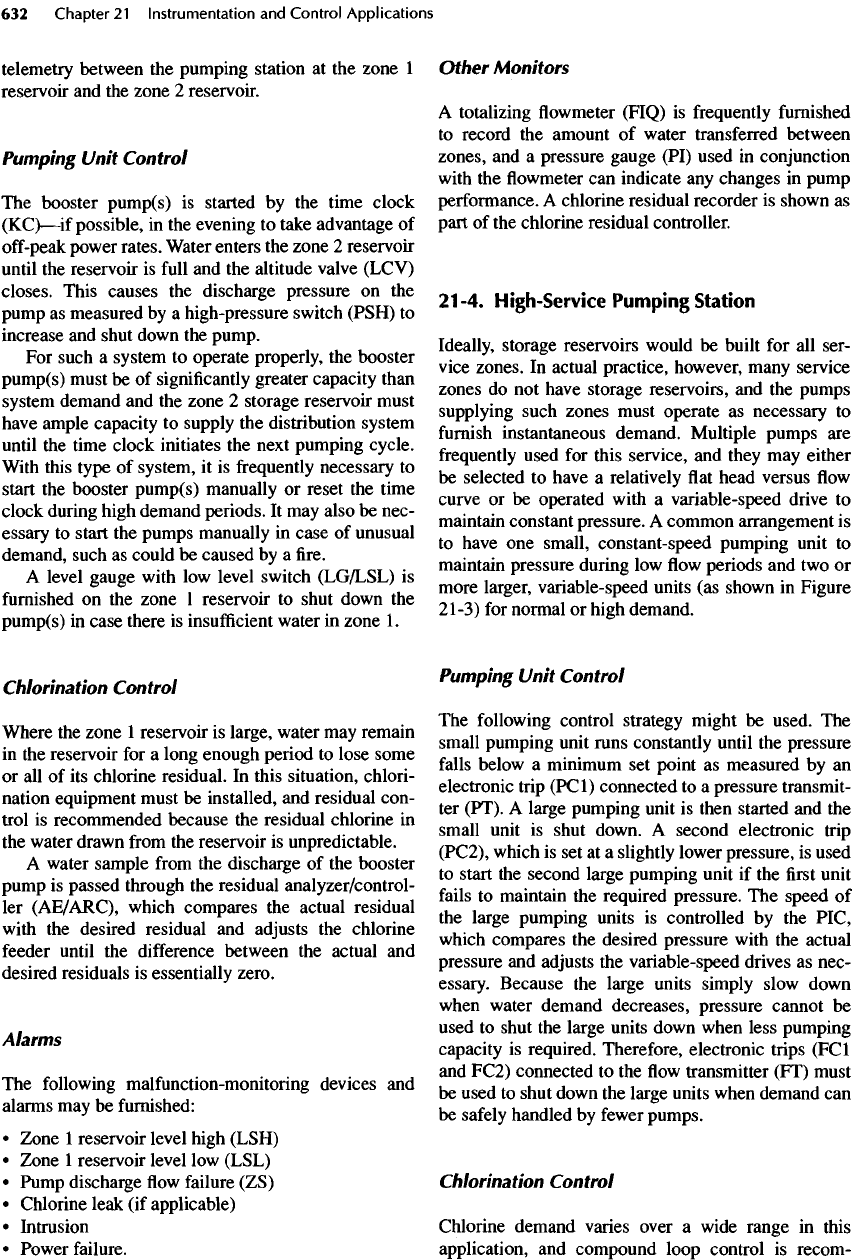
telemetry between
the
pumping station
at the
zone
1
reservoir
and the
zone
2
reservoir.
Pumping Unit
Control
The
booster pump(s)
is
started
by the
time
clock
(KC)
—
if
possible,
in the
evening
to
take advantage
of
off-peak
power rates. Water enters
the
zone
2
reservoir
until
the
reservoir
is
full
and the
altitude valve (LCV)
closes.
This causes
the
discharge pressure
on the
pump
as
measured
by a
high-pressure switch (PSH)
to
increase
and
shut down
the
pump.
For
such
a
system
to
operate properly,
the
booster
pump(s)
must
be of
significantly greater capacity than
system
demand
and the
zone
2
storage reservoir must
have
ample capacity
to
supply
the
distribution system
until
the
time clock initiates
the
next pumping cycle.
With
this type
of
system,
it is
frequently necessary
to
start
the
booster pump(s) manually
or
reset
the
time
clock during high demand
periods.
It may
also
be
nec-
essary
to
start
the
pumps manually
in
case
of
unusual
demand, such
as
could
be
caused
by a fire.
A
level gauge with
low
level switch
(LG/LSL)
is
furnished
on the
zone
1
reservoir
to
shut down
the
pump(s)
in
case there
is
insufficient
water
in
zone
1.
Chlorination
Control
Where
the
zone
1
reservoir
is
large, water
may
remain
in
the
reservoir
for a
long enough period
to
lose some
or
all of its
chlorine residual.
In
this situation,
chlori-
nation
equipment must
be
installed,
and
residual con-
trol
is
recommended because
the
residual chlorine
in
the
water drawn
from
the
reservoir
is
unpredictable.
A
water sample
from
the
discharge
of the
booster
pump
is
passed through
the
residual analyzer/control-
ler
(AE/ARC),
which compares
the
actual residual
with
the
desired residual
and
adjusts
the
chlorine
feeder
until
the
difference
between
the
actual
and
desired residuals
is
essentially zero.
Alarms
The
following malfunction-monitoring devices
and
alarms
may be
furnished:
•
Zone
1
reservoir level high (LSH)
•
Zone
1
reservoir level
low
(LSL)
•
Pump discharge
flow
failure (ZS)
•
Chlorine leak
(if
applicable)
•
Intrusion
•
Power
failure.
Other
Monitors
A
totalizing
flowmeter
(FIQ)
is
frequently furnished
to
record
the
amount
of
water transferred between
zones,
and a
pressure gauge (PI) used
in
conjunction
with
the flowmeter can
indicate
any
changes
in
pump
performance.
A
chlorine residual recorder
is
shown
as
part
of the
chlorine residual controller.
21-4.
High-Service
Pumping
Station
Ideally, storage reservoirs would
be
built
for all
ser-
vice zones.
In
actual practice, however, many service
zones
do not
have storage reservoirs,
and the
pumps
supplying such zones must operate
as
necessary
to
furnish
instantaneous demand. Multiple pumps
are
frequently
used
for
this service,
and
they
may
either
be
selected
to
have
a
relatively
flat
head versus
flow
curve
or be
operated with
a
variable-speed drive
to
maintain
constant pressure.
A
common arrangement
is
to
have
one
small, constant-speed pumping unit
to
maintain pressure during
low flow
periods
and two or
more larger, variable-speed units
(as
shown
in
Figure
21-3)
for
normal
or
high demand.
Pumping Unit
Control
The
following control strategy might
be
used.
The
small pumping unit runs constantly until
the
pressure
falls
below
a
minimum
set
point
as
measured
by an
electronic trip
(PCl)
connected
to a
pressure transmit-
ter
(PT).
A
large pumping unit
is
then started
and the
small unit
is
shut down.
A
second electronic trip
(PC2), which
is set at a
slightly lower pressure,
is
used
to
start
the
second large pumping unit
if the first
unit
fails
to
maintain
the
required pressure.
The
speed
of
the
large pumping units
is
controlled
by the
PIC,
which
compares
the
desired pressure with
the
actual
pressure
and
adjusts
the
variable-speed drives
as
nec-
essary. Because
the
large units simply slow down
when
water demand decreases, pressure cannot
be
used
to
shut
the
large units down when
less
pumping
capacity
is
required. Therefore, electronic trips (FCl
and
FC2) connected
to the flow
transmitter (FT) must
be
used
to
shut down
the
large units when demand
can
be
safely
handled
by
fewer
pumps.
Chlorination
Control
Chlorine demand varies over
a
wide range
in
this
application,
and
compound loop control
is
recom-
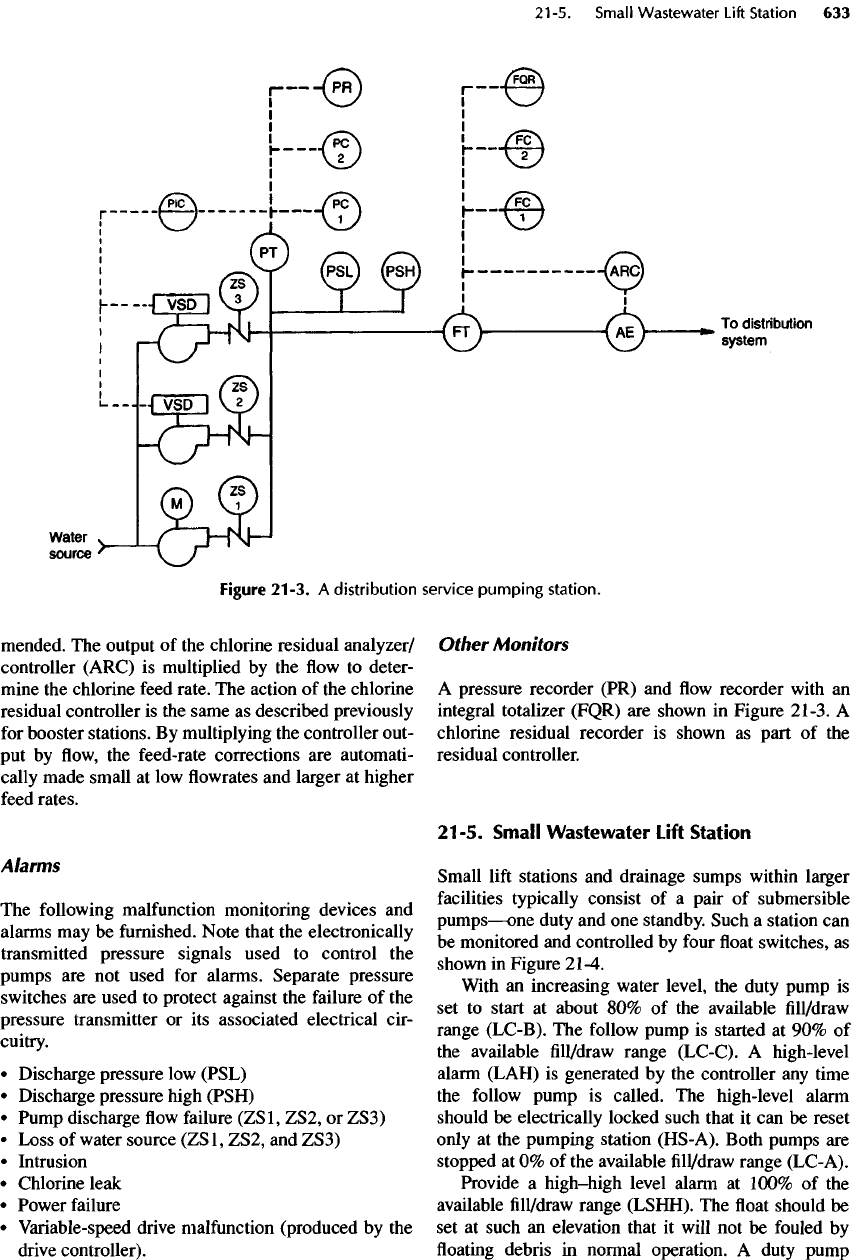
mended.
The
output
of the
chlorine residual analyzer/
controller (ARC)
is
multiplied
by the flow to
deter-
mine
the
chlorine
feed
rate.
The
action
of the
chlorine
residual controller
is the
same
as
described
previously
for
booster stations.
By
multiplying
the
controller out-
put
by flow, the
feed-rate corrections
are
automati-
cally
made small
at low flowrates and
larger
at
higher
feed
rates.
Alarms
The
following malfunction monitoring devices
and
alarms
may be
furnished. Note that
the
electronically
transmitted
pressure signals used
to
control
the
pumps
are not
used
for
alarms. Separate pressure
switches
are
used
to
protect against
the
failure
of the
pressure transmitter
or its
associated
electrical
cir-
cuitry.
•
Discharge pressure
low
(PSL)
•
Discharge pressure high (PSH)
•
Pump discharge
flow
failure
(ZSl,
ZS2,
or
ZS3)
•
Loss
of
water source
(ZS
1
,
ZS2,
and
ZS3)
•
Intrusion
•
Chlorine leak
•
Power
failure
•
Variable-speed drive
malfunction
(produced
by the
drive
controller).
Other
Monitors
A
pressure recorder
(PR)
and flow
recorder with
an
integral
totalizer
(FQR)
are
shown
in
Figure
21-3.
A
chlorine residual recorder
is
shown
as
part
of the
residual controller.
21-5.
Small
Wastewater
Lift
Station
Small
lift
stations
and
drainage sumps within larger
facilities
typically consist
of a
pair
of
submersible
pumps
—
one
duty
and one
standby. Such
a
station
can
be
monitored
and
controlled
by
four
float
switches,
as
shown
in
Figure
21-4.
With
an
increasing water level,
the
duty pump
is
set to
start
at
about
80% of the
available
fill/draw
range (LC-B).
The
follow pump
is
started
at 90% of
the
available
fill/draw
range (LC-C).
A
high-level
alarm (LAH)
is
generated
by the
controller
any
time
the
follow pump
is
called.
The
high-level alarm
should
be
electrically locked such that
it can be
reset
only
at the
pumping station (HS-A). Both pumps
are
stopped
at 0% of the
available
fill/draw
range (LC-A).
Provide
a
high-high
level alarm
at
100%
of the
available
fill/draw
range (LSHH).
The float
should
be
set at
such
an
elevation that
it
will
not be
fouled
by
floating
debris
in
normal operation.
A
duty pump
Figure
21-3.
A
distribution
service
pumping station.
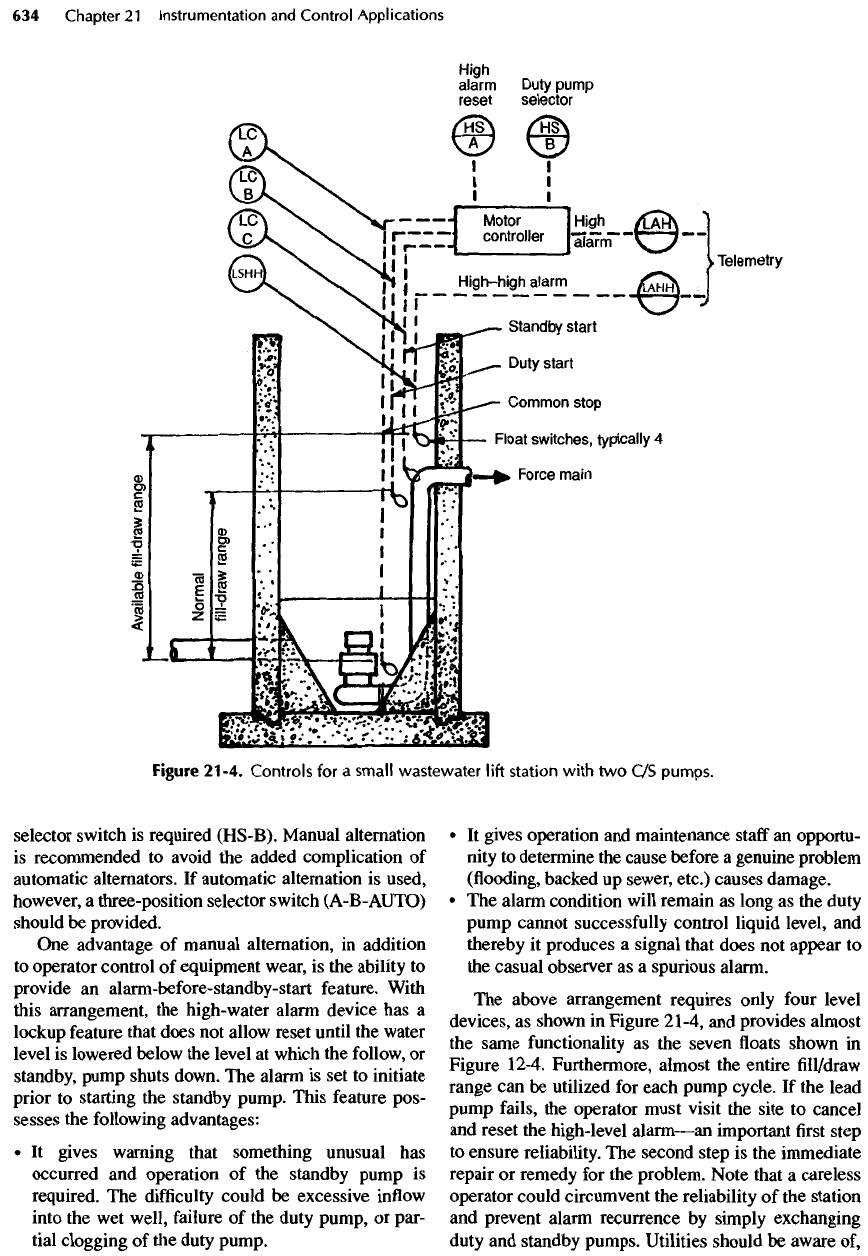
selector switch
is
required (HS-B). Manual alternation
is
recommended
to
avoid
the
added complication
of
automatic
alternators.
If
automatic alternation
is
used,
however,
a
three-position selector switch (A-B-AUTO)
should
be
provided.
One
advantage
of
manual alternation,
in
addition
to
operator
control
of
equipment wear,
is the
ability
to
provide
an
alarm-before-standby-start feature. With
this arrangement,
the
high-water alarm device
has a
lockup
feature
that does
not
allow reset until
the
water
level
is
lowered below
the
level
at
which
the
follow,
or
standby,
pump shuts down.
The
alarm
is set to
initiate
prior
to
starting
the
standby pump. This
feature
pos-
sesses
the
following advantages:
• It
gives warning that something unusual
has
occurred
and
operation
of the
standby pump
is
required.
The
difficulty
could
be
excessive
inflow
into
the wet
well,
failure
of the
duty pump,
or
par-
tial clogging
of the
duty pump.
• It
gives operation
and
maintenance
staff
an
opportu-
nity
to
determine
the
cause before
a
genuine problem
(flooding,
backed
up
sewer,
etc.)
causes damage.
• The
alarm condition will remain
as
long
as the
duty
pump
cannot successfully control liquid level,
and
thereby
it
produces
a
signal that does
not
appear
to
the
casual observer
as a
spurious alarm.
The
above arrangement requires only
four
level
devices,
as
shown
in
Figure
21-4,
and
provides
almost
the
same functionality
as the
seven
floats
shown
in
Figure
12-4.
Furthermore, almost
the
entire
fill/draw
range
can be
utilized
for
each pump cycle.
If the
lead
pump
fails,
the
operator must visit
the
site
to
cancel
and
reset
the
high-level
alarm
—
an
important
first
step
to
ensure reliability.
The
second
step
is the
immediate
repair
or
remedy
for the
problem. Note that
a
careless
operator could circumvent
the
reliability
of the
station
and
prevent alarm recurrence
by
simply exchanging
duty
and
standby pumps. Utilities should
be
aware
of,
Figure
21-4.
Controls
for a
small
wastewater
lift
station
with
two C/S
pumps.
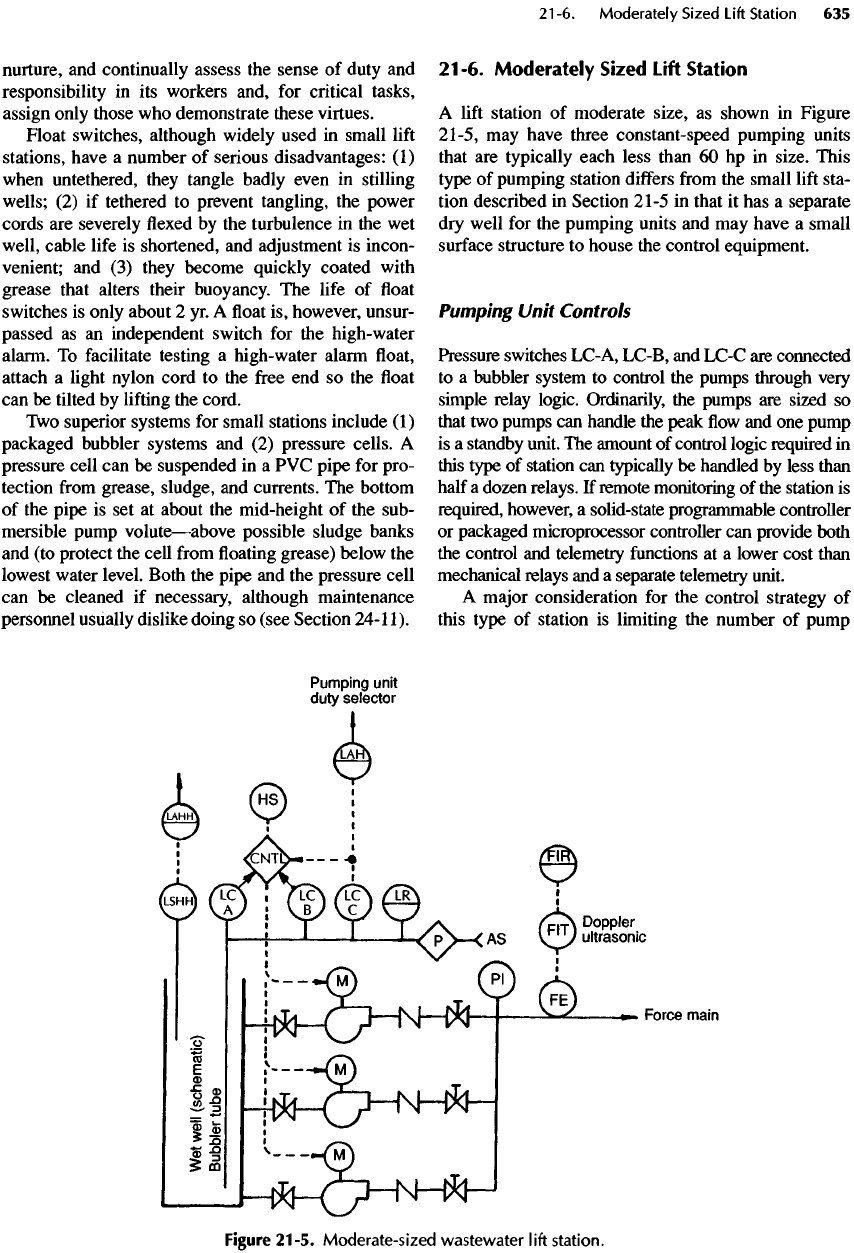
nurture,
and
continually assess
the
sense
of
duty
and
responsibility
in its
workers and,
for
critical tasks,
assign only those
who
demonstrate these virtues.
Float switches, although widely used
in
small
lift
stations, have
a
number
of
serious disadvantages:
(1)
when
untethered, they tangle badly even
in
stilling
wells;
(2) if
tethered
to
prevent tangling,
the
power
cords
are
severely
flexed by the
turbulence
in the wet
well, cable
life
is
shortened,
and
adjustment
is
incon-
venient;
and (3)
they become quickly coated with
grease that alters their buoyancy.
The
life
of float
switches
is
only about
2 yr. A float is,
however, unsur-
passed
as an
independent switch
for the
high-water
alarm.
To
facilitate testing
a
high-
water
alarm
float,
attach
a
light nylon cord
to the free end so the float
can be
tilted
by
lifting
the
cord.
Two
superior systems
for
small stations include
(1)
packaged bubbler systems
and (2)
pressure
cells.
A
pressure cell
can be
suspended
in a PVC
pipe
for
pro-
tection
from
grease, sludge,
and
currents.
The
bottom
of
the
pipe
is set at
about
the
mid-height
of the
sub-
mersible pump
volute
—
above
possible
sludge banks
and
(to
protect
the
cell
from
floating
grease) below
the
lowest water level. Both
the
pipe
and the
pressure cell
can
be
cleaned
if
necessary, although maintenance
personnel usually dislike doing
so
(see Section
24-1
1).
21-6.
Moderately Sized
Lift
Station
A
lift
station
of
moderate size,
as
shown
in
Figure
21-5,
may
have three constant-speed pumping
units
that
are
typically each less than
60 hp in
size. This
type
of
pumping station
differs
from
the
small
lift
sta-
tion
described
in
Section
21-5
in
that
it has a
separate
dry
well
for the
pumping units
and may
have
a
small
surface
structure
to
house
the
control equipment.
Pumping
Unit
Controls
Pressure switches LC-A, LC-B,
and
LC-C
are
connected
to a
bubbler system
to
control
the
pumps through
very
simple relay
logic.
Ordinarily,
the
pumps
are
sized
so
that
two
pumps
can
handle
the
peak
flow and one
pump
is
a
standby unit.
The
amount
of
control logic required
in
this
type
of
station
can
typically
be
handled
by
less than
half
a
dozen relays.
If
remote monitoring
of the
station
is
required, however,
a
solid-state programmable controller
or
packaged microprocessor controller
can
provide both
the
control
and
telemetry
functions
at a
lower cost than
mechanical relays
and a
separate telemetry unit.
A
major
consideration
for the
control strategy
of
this type
of
station
is
limiting
the
number
of
pump
Figure 21-5.
Moderate-sized
wastewater
lift
station.
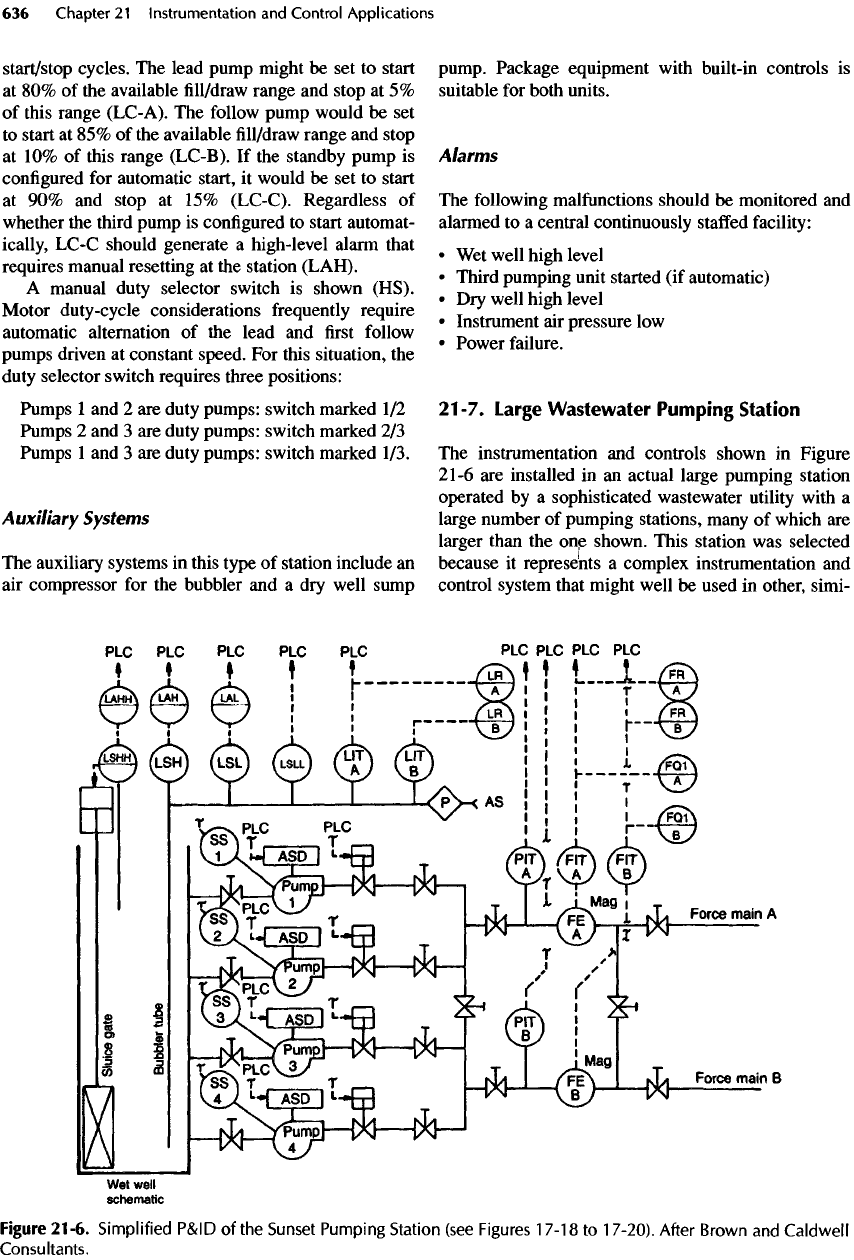
start/stop cycles.
The
lead pump might
be set to
start
at
80% of the
available
fill/draw
range
and
stop
at 5%
of
this range (LC-A).
The
follow pump would
be set
to
start
at 85% of the
available
fill/draw
range
and
stop
at
10%
of
this range (LC-B).
If the
standby pump
is
configured
for
automatic start,
it
would
be set to
start
at
90% and
stop
at 15%
(LC-C). Regardless
of
whether
the
third pump
is
configured
to
start automat-
ically,
LC-C
should generate
a
high-level alarm that
requires manual resetting
at the
station (LAH).
A
manual duty
selector
switch
is
shown
(HS).
Motor duty-cycle considerations frequently require
automatic alternation
of the
lead
and first
follow
pumps
driven
at
constant speed.
For
this situation,
the
duty
selector
switch requires three
positions:
Pumps
1 and 2 are
duty pumps: switch marked
1/2
Pumps
2 and 3 are
duty
pumps: switch marked
2/3
Pumps
1 and 3 are
duty pumps: switch marked
1/3.
Auxiliary Systems
The
auxiliary systems
in
this type
of
station include
an
air
compressor
for the
bubbler
and a dry
well sump
pump. Package equipment with built-in controls
is
suitable
for
both units.
Alarms
The
following malfunctions should
be
monitored
and
alarmed
to a
central continuously
staffed
facility:
• Wet
well high level
•
Third pumping unit started
(if
automatic)
• Dry
well high level
•
Instrument
air
pressure
low
•
Power failure.
21-7.
Large
Wastewater
Pumping
Station
The
instrumentation
and
controls shown
in
Figure
21-6
are
installed
in an
actual large pumping station
operated
by a
sophisticated
wastewater utility with
a
large number
of
pumping stations, many
of
which
are
larger than
the one
shown. This station
was
selected
because
it
represents
a
complex instrumentation
and
control system that might well
be
used
in
other,
simi-
Figure
21-6.
Simplified
P&ID
of the
Sunset
Pumping Station (see
Figures
17-18
to
17-20).
After Brown
and
Caldwell
Consultants.
